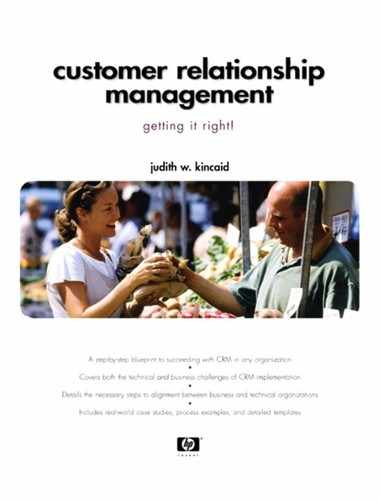7.2. Bridging Organizational Gaps
We have described a highly complex organizational structure that requires significant cooperation and coordination across functions because CRM does not fit neatly under one single management structure. We need to learn how to operate efficiently in this cross-functional environment.
7.2.1. Operating across Business Functions
The key weapon for overcoming organization gaps that are the focus here is how to set up an organization and leadership structure for our program that clearly defines roles, responsibilities, and communication paths. This organizational and leadership structure is what will help you operate effectively across all the involved functions; you must build a strong platform that supports the successful interactions between your company and your customers (see Figure 7-3).
Figure 7-3. The CRM infrastructure bridging organizational silos

The knowledge and perspective of each core function will be contributed through member participation in the steering committee, program council, and project teams. The need for broad perspective and in-depth knowledge is why these teams should be comprised of respected people from within each function. It is also critical that members take ownership for communicating, gathering information, and managing compliance within their respective functional areas.
7.2.2. The Business/Information Technology Relationship
It's all about communication. The communication disconnects between business process owners and technology people are widely experienced. These two groups of people even speak a totally different language. Clear communication is critical, but so is understanding that there are two perspectives and that both are important.
For years, we've encouraged programmers to focus on the business problem and not just the wizardry of the technical solution. Most IT professionals understand this and want to solve real business problems. Otherwise, they would take jobs in labs somewhere. But these IT folks usually don't have actual experience performing the business tasks, so they need guidance from the business professionals. Good communication between business functions and IT functions has never been more important.
In Chapter 5, we introduced the CRM life cycle:
Develop your company's overall CRM strategy
Build the infrastructure a piece at a time
Know (analyze and target) who your customers area
Deliver the offer to your customers
We also learned about how primary responsibility passes back and forth throughout the CRM life cycle, from heavy business involvement during strategic planning, to almost total Information Technology responsibility during the infrastructure build stage. As we begin to deliver results to our customers outside, the responsibility shifts back to the business team. More IT department involvement occurs during the customer analysis phases, but the responsibility shifts almost totally to the business function as the offer is delivered. In no phase should either constituent group be totally uninvolved.
On the business side, especially with the growth of the Internet, it is no longer appropriate for business people to treat technology as if it were some mysterious black box that they don't want to know anything about. It's not okay to toss a business problem or need to the IT department, and then shrug your shoulders and wait until the system is completed. (This probably won't work, so don't do it.) Marketing managers don't need to learn to write computer code, but they certainly need to understand the basic capabilities of some of the new technologies they depend on. It's important to understand that there is no magic, and that there are some things computers just can't do well (at least not yet).
The first step in assuring good communication is to understand the expectations for each part of the team. It is important to recognize that when the business function and IT department are working together, they have two different responsibilities. The business function is responsible for clearly defining what it needs—the business requirements for information and process automation. Information Technology needs to validate its understanding of the business need and propose the best technological solution to meet the needs. In many cases, there will be alternative solutions available with different pros and cons. These alternatives must be reviewed with the business team for a decision on the appropriate trade-off. Table 7-3 has several examples of business requirements and possible IT solutions.
| Business Requirement | IT Solutions |
|---|---|
| Sales reps spend too much time in the office working on record-keeping. We need to increase the amount of time they can spend in front of customers. (NOT: We need a sales force automation system.) |
|
| We have no way of knowing all the interactions our customers have had with the company. (NOT: Build us a marketing database.) |
|
| We don't have a clue as to who our best customers really are. (NOT: Go buy Package A so we can analyze our customers.) |
|
Now that we're set to go, we'll begin the real work. In Chapter 8, we will develop our strategic plan.
